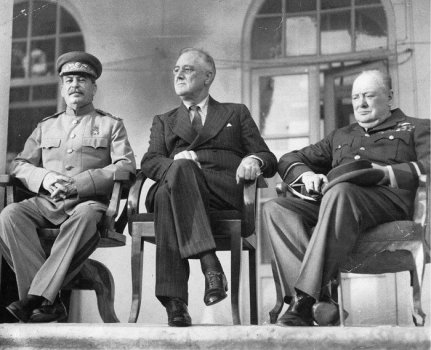The Red Tsar
October 24, 2015 § 2 Comments

Stalin the affectionate father. Stalin the charmer. Stalin the flirt. Stalin the benevolent friend. Hardly the images one associates with Joseph Vissarionovich Dzugashvili, better known to the world as Joseph Stalin. We grapple with trying to understand men such as Stalin because the distilled evil that he embodies is beyond our comprehension. But it’s far too easy to dismiss him as a sadistic, paranoid schizophrenic. By reading The Court of the Red Tsar a more rounded picture of the Georgian emerges: here was a man driven by belief (in Marxist-Leninist ideology) and ambition. Stalin believed in Russian chauvinism (Orwell was right when he said that nationalism arises in the periphery). He fervently believed in the ideology that his party espoused. Stalin was more like a local mafioso, as opposed to the demagogue that Hitler was, and that he knew he had to work his way to the top; maneuver deftly, look after his associates, and build his court. He was no plodding mediocrity.
Montefiore, through thorough research, portrays the intimate, human aspect to these Bolsheviks: their love letters; their families; their illnesses; their relationships; the debauchery; treachery; the jealousies. When these insights are combined with historical events such as the Terror, or the Cold War then one gains an understanding of what was going through their minds. This intimate portrait though, does not in any way soften or make the Bolsheviks more appealing, but on the contrary: makes them the more horrifying and sinister. The cruel fashion in which they destroyed party members, friends, and even family members, sentenced thousands to execution or forced labour camps is gut-wrenching. At the root of all this was ideology: a fanatical and fundamentalist belief in the righteousness of their actions. Brings to mind Solzhenitsyn’s words:
“Macbeth’s self-justifications were feeble – and his conscience devoured him. Yes, even Iago was a little lamb, too. The imagination and spiritual strength of Shakespeare’s evildoers stopped short at a dozen corpses. Because they had no ideology. Ideology – that is what gives evildoing its long-sought justification and gives the evildoer the necessary steadfastness and determination.”
There are two flaws to the book: Montefiore discovered so much material that he had a hard time deciding what to keep and what to discard, and so couldn’t resist adding “juicy tidbits”. Result being that the book abounds in footnotes, to the point of being annoying and distracting. Couple that with his style of writing, especially in the first few chapters, I got the feeling that I was reading a historical, gossip column: it does have that slightly trashy feel to it. Despite these flaws I found the book to be very rewarding and a valuable look at the poster boy for tyrannical dictators but also at a rather enigmatic, lonely, paranoid, determined, perverse man hailed as Russia’s last Tsar.
Stalin: The Court of the Red Tsar by Simon Sebag Montefiore
published by Phoenix
Image: The ‘Big Three’ at the Tehran Conference
[…] Stalin: The Court of the Red Tsar by Simon Sebag Montefiore […]
LikeLike
[…] above phrase was elicited from Simon Sebag Montefiore when he was on a book tour promoting his book Stalin: Court of the Red Tsar, and the interviewer asked him if he saw a movie deal in the making. At the time I only understood […]
LikeLike